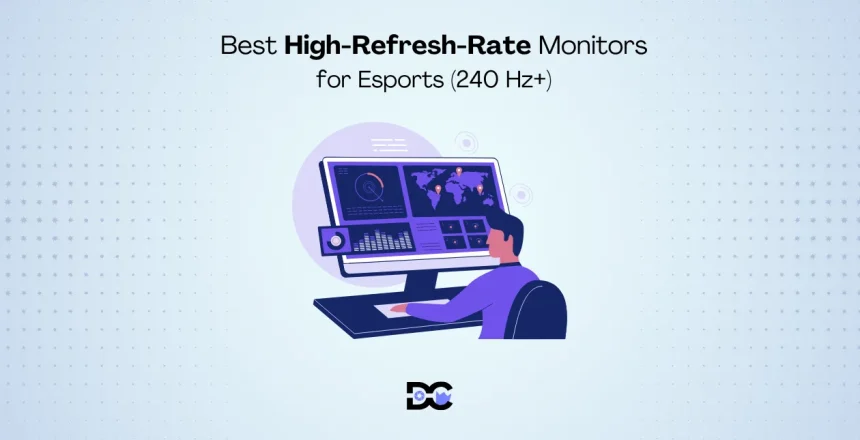If you’re a competitive gamer struggling with motion blur, screen tearing, or slow reaction times, your monitor might be the limiting factor. These issues can make games feel choppy and cause you to lose track of fast-moving targets, affecting overall performance.
Your monitor’s refresh rate plays a major role in how smoothly visuals appear. A 60 Hz display refreshes only 60 times per second, causing noticeable lag and blur. Upgrading to 144 Hz improves fluidity significantly, but even that can leave milliseconds of delay—enough to make a difference in high-level play. Studies show that while the jump from 60 Hz to 144 Hz is dramatic, the step up to 240 Hz can still provide a measurable competitive edge.
A high-refresh-rate monitor (240 Hz or higher) refreshes up to 360 times per second, delivering ultra-smooth gameplay with minimal input lag and motion blur. This upgrade ensures faster reactions, clearer visuals, and more precise control—giving you the clarity and responsiveness needed to compete like the pros. This guide will help you choose the best high-refresh-rate monitors for esports, so your equipment performs at the same level as your skills.
Considerations When Choosing High-Refresh-Rate Monitors
To ensure you choose the best high-refresh-rate monitor for your needs, consider the following key factors:
Resolution vs. Refresh Rate
High-refresh-rate monitors come in various resolutions, most commonly 1080p (Full HD), 1440p (QHD), and 4K (UHD). There is often a trade-off between resolution and the ability to achieve a high frame rate.
- 1080p (FHD): This resolution is the least demanding on your graphics card (GPU). It is ideal for competitive gaming where you prioritize the highest possible frame rates (e.g., 240+ FPS) without straining your hardware.
- 1440p (QHD): Considered a “sweet spot” for many gamers, QHD offers a good balance between visual clarity and performance. A powerful GPU can achieve high refresh rates at this resolution, providing a crisp image and smooth gameplay.
- 4K (UHD): While 4K offers the most detailed and visually stunning image, it is extremely demanding on your GPU. To take advantage of a high refresh rate at 4K, you will need a top-tier graphics card to maintain a high frame rate.
Panel Technology
The type of panel a monitor uses directly impacts its performance, color accuracy, and price.
- OLED (Organic Light-Emitting Diode): OLED panels offer the best of all worlds, with perfect blacks, infinite contrast, and the fastest response times (as low as 0.03 ms). They are ideal for both vibrant single-player games and competitive titles. However, they are also the most expensive and have a potential risk of screen burn-in.
- TN (Twisted Nematic): TN panels were traditionally the go-to for competitive gamers due to their fast response times (as low as 1 ms) and high refresh rates. They are also the most affordable. The main downsides are poor color accuracy and narrow viewing angles.
- IPS (In-Plane Switching): IPS panels offer excellent color accuracy and wide viewing angles, making them a great all-around choice. In recent years, IPS technology has advanced, with some “SuperSpeed IPS” panels now achieving low response times (1 ms) and high refresh rates, narrowing the gap with TN panels.
- VA (Vertical Alignment): VA panels provide better contrast and deeper blacks than IPS and TN, making them suitable for immersive gaming and movie watching. However, their response times are generally slower than IPS and TN panels, which can cause ghosting in fast-paced games.
Response Time
Response time measures how quickly a pixel can change from one color to another, typically measured in milliseconds (ms) from gray-to-gray (GtG). A lower response time is crucial for high-refresh-rate gaming, as it reduces motion blur and ghosting. For a 240 Hz monitor, a response time of 1 ms or less is ideal to keep up with the rapid frame changes.
Adaptive Sync (G-Sync vs. FreeSync)
Adaptive sync technologies synchronize the monitor’s refresh rate with your GPU’s frame rate. This eliminates screen tearing and stuttering, creating a smoother gaming experience.
- NVIDIA G-Sync: G-Sync uses a proprietary hardware module in the monitor to provide consistent performance and features like Variable Overdrive and Ultra Low Motion Blur (ULMB). It works exclusively with NVIDIA graphics cards and is generally more expensive.
- AMD FreeSync: FreeSync is an open-source standard that does not require a hardware module, making it more affordable and widely available on monitors. It works with AMD GPUs and is also compatible with many NVIDIA cards under “G-Sync Compatible” mode.
Best Popular High-Refresh-Rate Monitors for Esports (240 Hz+)
| Monitor Name | Panel Type | Native Resolution | Refresh Rate | Response Time | Starting Price (USD) |
| ASUS ROG Swift OLED PG27UCDM | QD-OLED | 3840 x 2160 (4K) | 240 Hz | 0.03 ms GtG | ~$1,099 |
| Alienware AW2725DF | QD-OLED | 2560 x 1440 (QHD) | 360 Hz | 0.03 ms GtG | ~$730 |
| MSI MPG 321URX QD-OLED | QD-OLED | 3840 x 2160 (4K) | 240 Hz | 0.03 ms GtG | ~$899 |
| BenQ ZOWIE XL2546K | TN | 1920 x 1080 (FHD) | 240 Hz | 0.5 ms GtG | ~$430 |
| LG UltraGear 27GS95QE | OLED | 2560 x 1440 (QHD) | 240 Hz | 0.03 ms GtG | ~$900 |
| Samsung Odyssey G7 | IPS | 3840 x 2160 (4K) | 144 Hz | 1 ms GtG | ~$599 |
| Corsair XENEON 27QHD240 | OLED | 2560 x 1440 (QHD) | 240 Hz | 0.03 ms GtG | ~$999 |
| Gigabyte M27Q X | SS IPS | 2560 x 1440 (QHD) | 240 Hz | 1 ms GtG | ~$399 |
ASUS ROG Swift OLED PG27UCDM
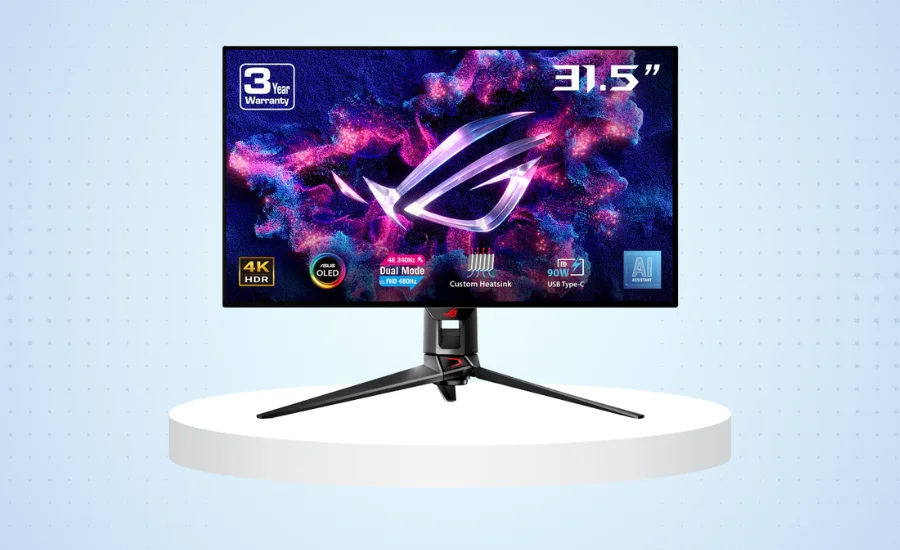
Released in early 2025, the ASUS ROG Swift OLED PG27UCDM is a premium gaming monitor that brings together a 4K resolution with a high refresh rate.
It is one of the world’s first 27-inch 4K OLED gaming monitors and is designed for gamers who want the best of both worlds: incredible visual fidelity and competitive performance.
The monitor features the latest fourth-generation QD-OLED technology, which provides exceptional image quality with infinite contrast and a pixel density of 166 ppi for sharp visuals and clear text. It also includes technologies to protect the screen from burn-in, a common concern with OLED panels, such as ROG OLED Care Pro.
Key Features:
- 4K resolution with 240 Hz refresh rate
- 0.03 ms GtG response time
- ROG OLED Care Pro for burn-in prevention
- DisplayPort 2.1 and HDMI 2.1 connectivity
- VESA DisplayHDR 400 True Black and Dolby Vision support
Starting Price: ~$1,099
Alienware AW2725DF
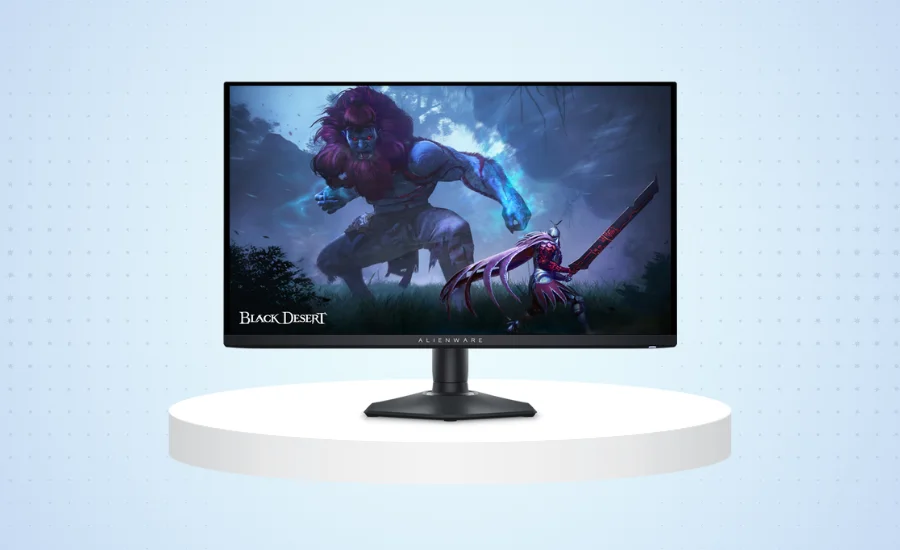
This monitor is a powerhouse for competitive gamers, offering an incredibly high 360 Hz refresh rate. With its QD-OLED panel, the AW2725DF delivers the deep blacks and vibrant colors that OLED technology is known for, alongside the blazing speed required for esports.
Dell’s Alienware brand is well-regarded for its high-performance gaming hardware, and this monitor is a prime example.
The anti-reflection screen coating reduces glare, allowing you to stay focused during intense gaming sessions. Its design is also highly functional, featuring a hexagonal base that takes up less desk space and a fully adjustable stand.
Key Features:
- 360 Hz refresh rate for QHD resolution
- 0.03 ms GtG response time
- QD-OLED panel for infinite contrast and deep blacks
- Anti-reflection screen coating
- AMD FreeSync Premium Pro and NVIDIA G-SYNC compatibility
Starting Price: ~$730
MSI MPG 321URX QD-OLED
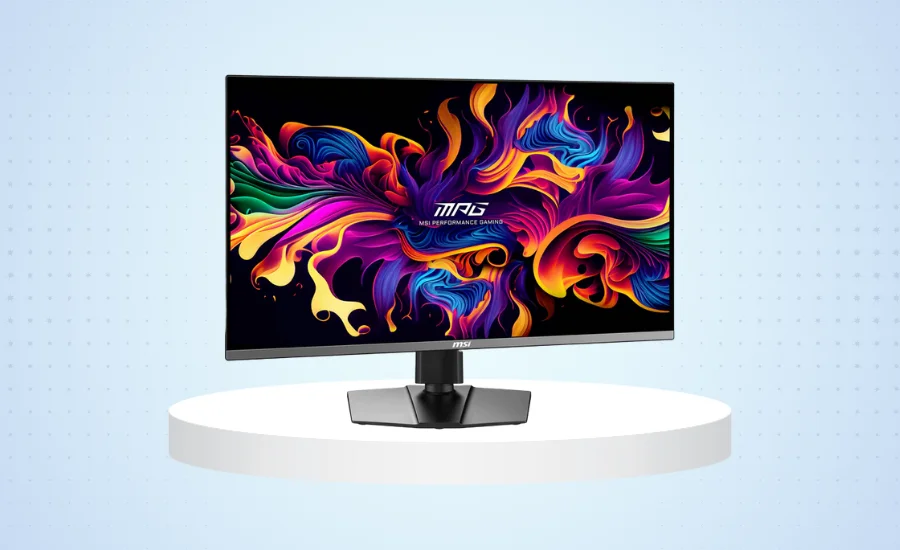
MSI’s MPG 321URX QD-OLED is a 32-inch 4K monitor designed for gamers who want a larger screen without sacrificing speed.
It combines a sharp 4K resolution with a 240 Hz refresh rate, making it a great option for both immersive single-player games and fast-paced competitive titles.
The monitor features MSI’s OLED Care 2.0, which includes a passive heatsink and graphene film to prevent burn-in and ensure long-term performance without a noisy fan. It also supports HDMI 2.1, providing full bandwidth for next-gen consoles at 4K 120Hz.
Key Features:
- 4K resolution with 240 Hz refresh rate
- 0.03 ms GtG response time
- OLED Care 2.0 with fan-less heat dissipation
- VESA DisplayHDR True Black 400
- HDMI 2.1 ports with full 48 Gbps bandwidth
Starting Price: ~$899
BenQ ZOWIE XL2546K
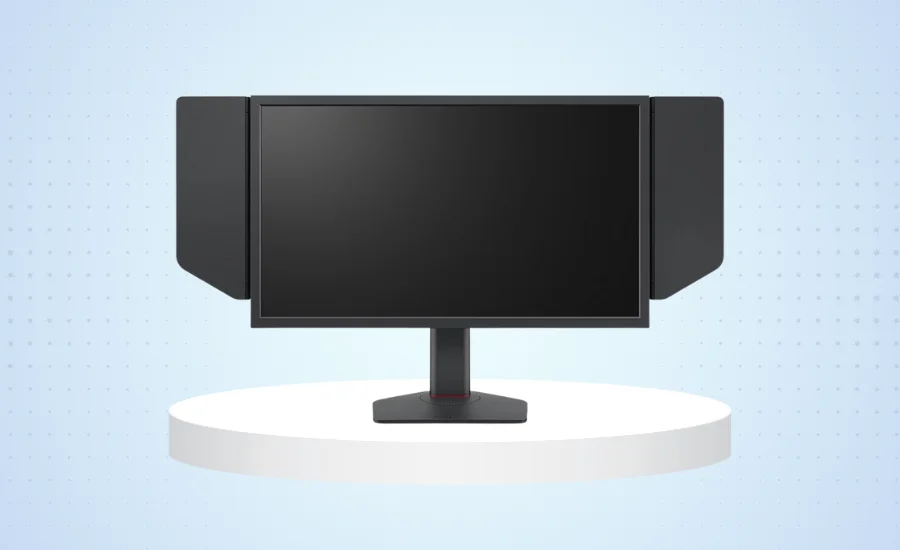
BenQ’s ZOWIE lineup is a staple in the esports community, and the XL2546K is a testament to that legacy. Unlike the OLED monitors, this one uses a TN panel, prioritizing raw speed and low input lag over color fidelity.
The monitor’s key feature is DyAc+ (Dynamic Accuracy Plus) technology, which significantly reduces motion blur during intense movements like spraying a weapon.
The XL2546K has a minimal design with a smaller base for more desk space, which is a practical consideration for competitive players. It is built for a single purpose: to give esports professionals the highest possible performance.
Key Features:
- 240 Hz refresh rate
- DyAc+ technology for superior motion clarity
- Customizable Quick Access Settings via S-Switch
- Black eQualizer to increase visibility in dark scenes
- Smaller base for more desk space
Starting Price: ~$430
LG UltraGear 27GS95QE
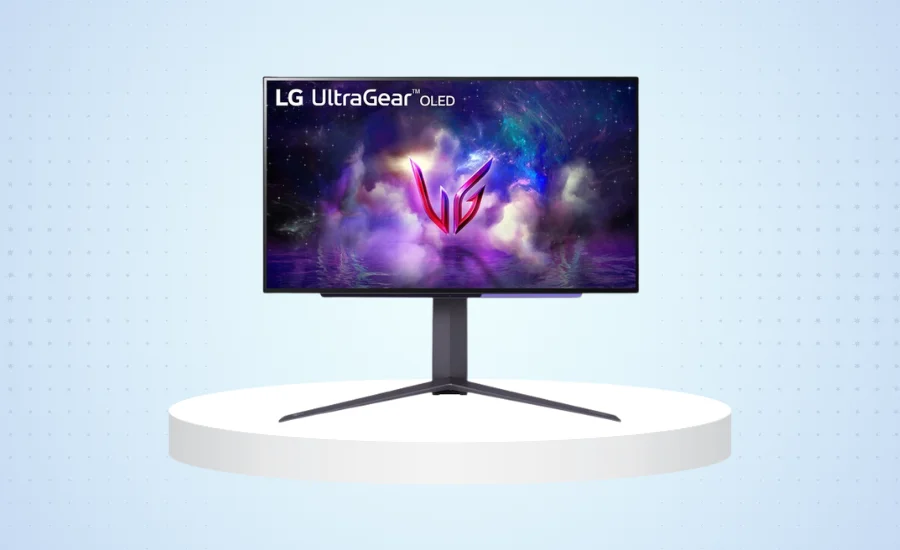
The LG UltraGear 27GS95QE is a 27-inch OLED monitor that offers a blend of high-end visuals and competitive performance.
It features a QHD resolution and a 240 Hz refresh rate, which is an ideal combination for many gaming setups, as it is less demanding on your GPU than 4K while still providing a crisp image.
The monitor supports both NVIDIA G-Sync and AMD FreeSync Premium Pro, ensuring tear-free gaming with a wide range of graphics cards. The display’s 0.03 ms GtG response time is virtually instantaneous, giving players an edge in fast-paced games.
Key Features:
- QHD resolution with 240 Hz refresh rate
- 0.03 ms GtG response time
- VESA DisplayHDR 400 True Black
- NVIDIA G-Sync Compatible and AMD FreeSync Premium Pro
- 4-Pole Headphone out with DTS HP:X support
Starting Price: ~$900
Samsung Odyssey G7
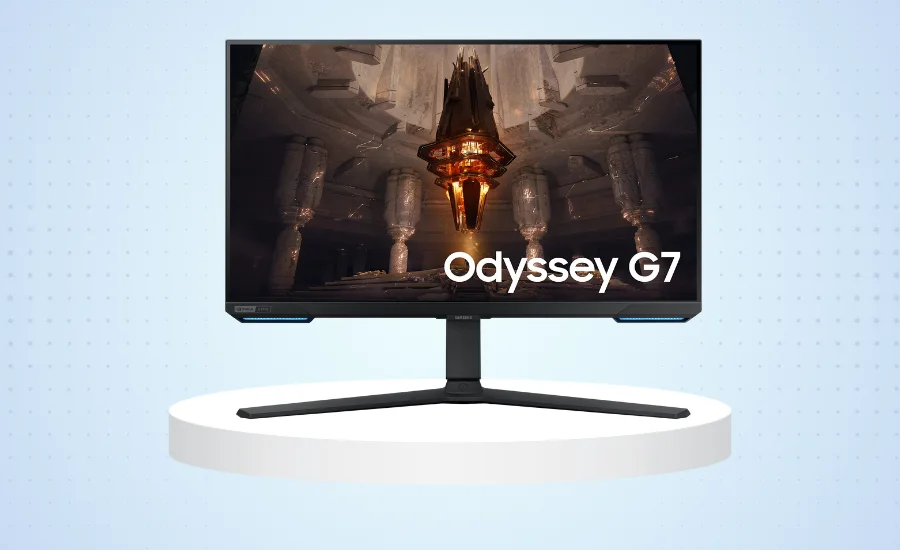
The Samsung Odyssey G7 is a 28-inch 4K gaming monitor that stands out for its immersive display and smart features.
While its 144 Hz refresh rate is a step below the 240 Hz and 360 Hz models, it is still a strong choice for competitive gamers who want the sharpness of a 4K resolution.
The IPS panel provides great color accuracy and wide viewing angles. A unique feature of this monitor is the Samsung Gaming Hub, which allows you to stream games without a PC. The monitor also supports FreeSync Premium Pro and G-Sync compatibility to ensure smooth, tear-free visuals.
Key Features:
- 4K resolution with a 144 Hz refresh rate
- 1 ms GtG response time
- Built-in smart TV features and Gaming Hub
- VESA DisplayHDR 400 and HDR10+ Gaming support
- FreeSync Premium Pro and G-Sync compatible
Starting Price: ~$599
Corsair XENEON 27QHD240
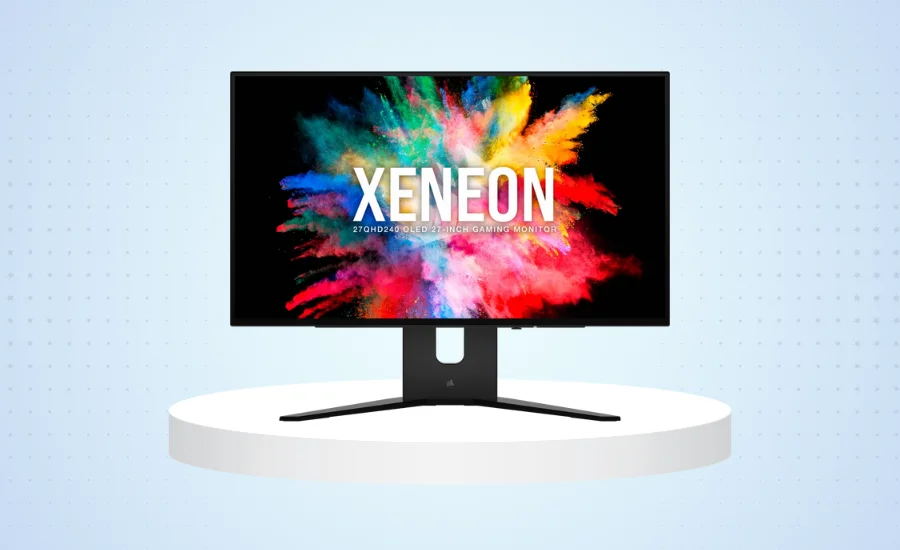
Corsair, a well-known name in PC components, brings its expertise to the monitor market with the XENEON 27QHD240. This 27-inch OLED monitor boasts a QHD resolution and a 240 Hz refresh rate, offering a high-performance visual experience.
The monitor is equipped with LG Display’s OLED META technology, which delivers vivid colors and a stunning 1.5M:1 contrast ratio.
Its non-glare display surface and low blue light features are designed to reduce eye strain during long gaming sessions. Corsair’s reputation for quality is backed by a solid 3-year warranty that includes burn-in protection.
Key Features:
- QHD resolution with 240 Hz refresh rate
- 0.03 ms GtG response time
- OLED META Technology and non-glare display
- NVIDIA G-Sync Compatible
- 3-year warranty with burn-in coverage
Starting Price: ~$999
Gigabyte M27Q X
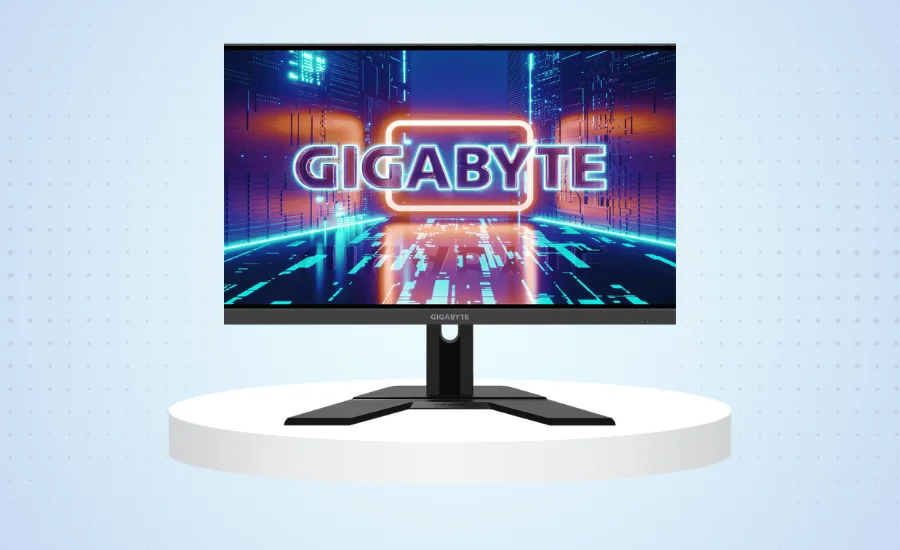
The Gigabyte M27Q X is a popular choice for gamers looking for a high-performance QHD monitor at a more accessible price point.
It features a SuperSpeed (SS) IPS panel, which provides the fast 1ms GtG response time needed for competitive play while maintaining the excellent color accuracy and viewing angles of an IPS display.
With a 240 Hz refresh rate, it provides a fluid and responsive gaming experience. The monitor also includes a built-in KVM switch, which is a great productivity tool for users with multiple devices.
Key Features:
- QHD resolution with 240 Hz refresh rate
- 1 ms GtG response time from SuperSpeed IPS
- Built-in KVM switch for controlling multiple devices
- VESA DisplayHDR 400
- Flicker-Free and Low Blue Light technologies
Starting Price: ~$399
FAQs
Is 240 Hz truly necessary for esports?
Yes, for professional and highly competitive esports players, a 240 Hz or higher refresh rate is essential. It provides a noticeable advantage by reducing input lag and motion blur, allowing for faster reaction times and better target tracking.
What is the difference between OLED and LCD monitors for gaming?
OLED monitors offer superior picture quality with infinite contrast and faster response times. LCD monitors, including TN and IPS panels, are generally more affordable and can achieve high refresh rates, with TN panels being the fastest but having poorer color quality.
Do I need a powerful PC to use a 240 Hz monitor?
Yes, to get the full benefit of a 240 Hz monitor, your PC must be able to consistently produce frame rates close to or above 240 FPS in the games you play. A powerful CPU and GPU are required.
What is response time and why does it matter?
Response time is the time it takes for a pixel to change color. A lower response time (e.g., 1ms or 0.03ms) is crucial for gaming because it reduces ghosting and motion blur, ensuring a clear image during fast-paced action.
How do I know if my PC can handle a 240 Hz monitor?
You can use a frame rate monitoring utility like Fraps to check your average FPS in games. If your average FPS is consistently above 200, you will likely benefit from a 240 Hz monitor.
What is the benefit of a QHD (1440p) resolution vs. 4K on a high-refresh-rate monitor?
QHD provides a good balance of visual sharpness and performance. It is easier for your PC to achieve high frame rates at QHD compared to 4K, making it a popular choice for competitive gaming.
Is a TN panel still a good option for competitive gaming?
Yes, TN panels like the one in the BenQ ZOWIE XL2546K are still favored by some esports players for their extremely low response times and the DyAc+ technology, which focuses solely on motion clarity over visual fidelity.
What is screen tearing?
Screen tearing is a visual artifact where the display shows a mix of two or more frames at once, appearing as a horizontal tear. High refresh rates and adaptive sync technologies like G-Sync and FreeSync help to eliminate this issue.
Are OLED monitors susceptible to burn-in?
Older OLED technology was more prone to burn-in, but modern gaming OLED monitors from brands like ASUS, Alienware, and MSI have advanced technologies like pixel shifting and heatsinks to significantly reduce the risk and often come with burn-in warranties.
What is a KVM switch in a monitor?
A KVM switch is a feature that allows you to connect multiple computers or devices to a single monitor, keyboard, and mouse setup. It’s a convenient feature for users who switch between a gaming PC and a work laptop.
Conclusion
Choosing a high-refresh-rate monitor is a significant decision for any serious gamer. As this article has shown, monitors with 240 Hz or higher refresh rates are no longer just for professionals; they are becoming more accessible and essential for gaining a competitive edge. The market now offers a variety of panels, from the ultra-fast TN panels of the BenQ ZOWIE XL2546K to the visually stunning QD-OLED displays from ASUS, Alienware, and MSI.
While a 144 Hz monitor like the Samsung Odyssey G7 is a great starting point for 4K gaming, pushing to 240 Hz or 360 Hz with models like the Gigabyte M27Q X or Alienware AW2725DF can provide the millisecond-level advantage that makes a difference in competitive scenarios. Ultimately, the best monitor for you depends on your budget, your PC’s capabilities, and your personal preferences for resolution and panel technology. By investing in a high-refresh-rate display, you can ensure your hardware is no longer a limiting factor, allowing your skills and reflexes to shine.
